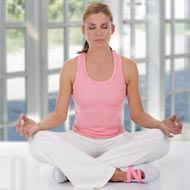- Aromatherapy (36)
- Benefits of Yoga (282)
- Home Remedies (1087)
- massage therapy (9)
- Preventive Therapy (135)
- Running (41)
- Skin Care (15)
- Stress Relief (25)
- Stretching (5)
- walking (33)
- Womens Health (14)
- Yoga Benefits for Pregnant Women (16)
- Yoga Benefits for Students (3)
- Yoga for Children (11)
- Yoga for Holistic Living (37)
- Yoga for Midlife Crisis (3)
- Yoga for Senior Citizens (2)
- Yoga for the Workplace (1)
- Yoga Health Tips (185)
- Yoga Practice during Menstruation (5)
Precaution Of Yoga Exercise To Be Taken While Suffering From Glaucoma

The Structure Of The Eye And Causes Of Glaucoma
The Eye: Made from soft but strong tissues, the eye has to maintain an accurate shape to focus light perfectly. The eye is kept in a firm shape by the clear fluid that is pumped into the eye from the bloodstream. This fluid contains sugars, oxygen and other nutrients. The fluid circulates inside the eye and then is drained through a mesh back into the bloodstream, where it is renewed. Since drainage is against resistance, the pressure of the eye is higher than air pressure, but lower than the pressure of the eye.
Glaucoma: In glaucoma the optic nerve at the back of the eye, is destroyed over a period of time. The process is slow and the damage happens because of increased pressure in the eye. The pressure increases either because the circulation of the fluid gets blocked or because the fluid cannot be drained out. Sometimes, glaucoma also happens because of poor blood supply to the optic nerve or a weak optic nerve.
Yoga And Glaucoma: While it's best to consult a doctor and speak to a qualified yoga instructor regarding the yoga poses that should be avoided, we have the following advice for you. If you've been doing yoga for several years, you could carry on with all other yoga postures except for the head stand and other postures which entail standing on your head or shoulders. The optic nerve is damaged because of an increase in eye pressure over a period of time. Other postures like Shavasana (Corpse's Pose) and Padmasana (Lotus Pose), and postures in which you have to sit, stand or lie down are not likely to affect your eyes.
But you must avoid head down postures. Sirasana (Head Down Posture) is not recommended for glaucoma patients as reports show that the IOP (intraocular pressure) increases to double in the headstand position, as compared to the sitting position.
Even though reports haven't shown any correlation between Sirasana and optic nerve damage, the rise in the IOP during this posture is a cause of concern. Doctors recommend that people above the age of 50, people at a risk of getting glaucoma or those with a family history of glaucoma, should first get their eyes checked before performing Sirasana. It is believed that people at the risk of getting glaucoma may get glaucoma if they practice Sirasana regularly. Shoulder stand and plough position should also be avoided if you have glaucoma or are at a risk of getting glaucoma.
- RSS Feeds -
- All posts
- All comments
- Yoga for Glaucoma Glaucoma is an eye condition characterized by the damage of the optical nerve...
- Yoga for Diarrhea The aim of yoga during a bout of diarrhoea is to strengthen the intestina...
- Yoga and Dermatomyositis Dermatomyositis can be described as a rare inflammatory disease, characterize...
- Does yoga have any anti-aging benefits? Yoga as a health system has been in practice for more than 5,000 years. It devel...